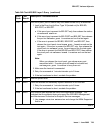
CAB-CALM (Customer alarm)
Issue 1 June 2005 737
CAB-CALM (Customer alarm)
G650
CAB-CALM provides control of a relay contact between a pair of leads from the TN2312BP IPSI
that can be wired to an external alarming device that is provided by the customer (CPAD). A
contact closure is provided between the leads when the alarm exceeds the level specified in the
CPE Alarm Activation Level field on the change system-parameters maintenance screen.
CAB-CALM is not associated with any background or demand tests that are used to clear
alarms. CAB-CALM becomes active when any other MO reaches a predetermined level (none,
warning, minor, or major) and generates an alarm. Clear the MO that is generating the alarm to
retire the contact closure across the CPAD relay contact.
If you think that there is a problem with the CPAD, you can test it by executing the test
customer-alarm command that activates the device closing the relay on the TN2312BP IPSI
for one minute. You can specify the repeat parameter to close the relay contact for a longer
time. The number of repeats that you specify is the number of minutes the external device is
activated.
System technician-demanded test:
Descriptions and error codes
The test customer-alarm location (short|long) r# command causes the TN2312BP
IPSI to:
● Close the CPAD relay contact for one minute
● Return to the state determined by the active alarm level specified by the CPE Alarm
Activation Level field on the change system-parameters maintenance screen
Customer Provided Alarming Device Test (#115)
The CPAD test closes the relay that activates the CPAD for one minute. If more than one minute
is necessary to verify the CPAD activation, you can change the repeat number on test
customer-alarm location to close the relay for up to 99 minutes. For example, specifying
r99 repeats for 99 minutes.
MO name in alarm
log
Alarm
level
Initial SAT command to run Full name of MO
CAB-CALM test customer-alarm location Customer Alarm
Order of investigation Short test
sequence
Long test
sequence
D/ND
Customer Provided Alarming Device Test (#115) X X Nondestructive


















